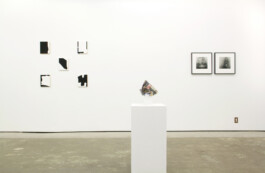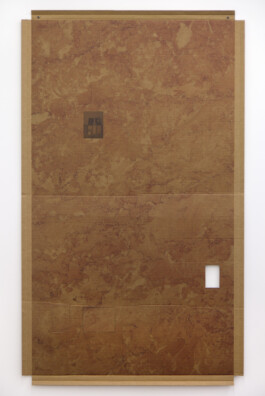


WINDOWS
MAY 12 - JUNE 17, 2017
David Peterson Gallery 2018 Lyndale Avenue S Minneapolis, MN 55405
David Petersen Gallery is pleased to present Windows, a group exhibition organized by Adam Marnie, Los Angeles-based artist and publisher of F Magazine. Rooted in the activities of the magazine, itself a window to potential exhibitions, Windows is a ten-artist exhibition—discussion—inventing, investigating and otherwise utilizing the object, image or metaphor of the window as a mediating interface for communication.







In conjunction with the exhibition, Marnie further articulates the window with a collaboratively created publication. Produced with Kevin Zucker, Windows Vista is a collection of sequenced images that traverse, elaborate and obscure exhibition-related constructs in poetic rumination. An edition of 200, Risograph printed, black and white, 8.5 x 7 inches, 60 pages and saddle-stiched, Windows Vista is available at the gallery for $10.
Aaron Aujla
Heather Bursch
Barbara Ess
Raina Hamner
Thatcher Keats
Rose Marcus
NOWORK
Kelsey Olson
Aura Rosenberg and Adam Marnie
Steel Stillman
This exhibition, my, let me tell you, I really didn’t see it coming, i.e. I knew it would arrive, the objects and images, but sheesh, it certainly took a turn Tuesday, an undeniably springtime afternoon in Minneapolis, the air and light strikingly warmer to the skin and to my eyes that couldn’t quite believe what they saw when we did this one thing, well, we did it with the artists, this one thing, it really took a turn, the exhibition did, and now I am expected to write about it, not just the one thing but all the things, most of which are by artists who I have never met, and would never have thought to show in this gallery (no offense, of course) where I don’t really like doing group shows anyway (again, no offense to any past group show participants), they just don’t suit the space in my opinion, the group shows, with the exception of last summer, maybe, to each their own though, I just prefer the intimacy of the solo exhibitions but in a strange way this is kind of a solo exhibition, i.e. Adam Marnie’s, with the twist that all of the objects and images are made by other artists, although after Tuesday I am starting to doubt that assumption, especially after Tuesday afternoon.
The elephant in the room just doesn’t mean what it used to.
We are just riffing here. Pick up one of the zines, Windows Vista, and feel the riff. That’s what I am trying to do now, it’s like a last resort, for the writing, an impossible task on what is now Thursday afternoon, to think of windows and how they are open and closed, transparent and opaque, revealing and concealing, centrifugal and centripetal all at the same time but I don’t want to bore you with the buts and nolts of the grid or mullions, screens and such, when I could just riff and pretentiously drop names like Rosalind Krauss, Marshall McLuhan or Bill Gates, all giants in their fields, real visionaries when it comes to how we see what we see. They each certainly changed my little life.
I thought I could give you a tour of the exhibition, beginning with the first piece to your left as you enter, by Rose Marcus, the only artist in the exhibition (other than the curator, of course) who has previously exhibited in the gallery, in springtime 2014, with a show entitled At Your Fingertips. I remember it well. The images in that exhibition, which were very much part and parcel of an installation, were of the inside, an interior space both public and private, a Manhattan Starbucks, in which men were awaiting their coffee orders while being surreptitiously photographed by the artist with various amounts of a point and shoot’s zoom lens. These photos make me think of both Barbara Ess’s voyeuristic piece facing out the front window, a space I would just as well avoid under normal circumstances anyway, that just might make a viewer feel like a peeper as they gaze through the glass; and Aura Rosenberg’s Paris-New York collaboration with the curator, a collage of shared photographs, layered and doubled, tripled and so on, close up croppings of Marnie’s croissant-holding hand on a cane’s crook and Rosenberg’s looksee views out of her NYC apartment. Rose’s photograph of an anonymous, ethereal figure in Inwood Hill Park, or superimposed there anyway, barely there anyway, feels less about the voyeur than that of, like, a ghost hunter, which might sound like a reach until I tell you that the site denoted by the park’s sign is Shorakkapok Rock, which itself denotes where the last tulip tree once stood in the park, i.e., the last living link with the Reckgawwanc Indians, who inhabited the land of what is now the park, which also happens to have the last remaining forest on the island, the island which was purportedly purchased by Peter Minuit from the Canarsees in 1626 while under the aforementioned tulip tree. I mean, if that doesn’t haunt you, what will?
Aaron Aujla’s painting of an interior with a view of both an exterior and what I can only conclude is a mirror image of more interior space is a psychological thriller, as is Barbara Ess’s second contribution to the show, though here in a more abstract and neurotic process-oriented sort of way. Both are seductively beautiful, if I may say so, which is why they catch you off guard when you hang out with them for longer than the customary five seconds that most folks give to viewing a work of art. Steel Stillman’s intimate architectural interiors tie the room together, almost literally, I mean, it’s not like the walls would fly away from one another but lets not take any chances. There is a lot of clinching going on here, Stillman’s paintings, as well as Kelsey Olson’s gelatin-based, paperless photograph that has contortedly dried itself to her plastic cup, the images twisting and turning in and out of view while mold has found a host. Thatcher Keats was in his very early 20’s when he began making his Identifying Marks photographs of his friends’ body parts of which we have the parts that might have the most, shall I say, tension, to spare you the obvious pun.
Heather Bursch just called and asked that we excise another rectangle from her faux marbled cardboard and use the extracted piece to replace the gallery’s electrical outlet cover all the way across the room. The piece contains two other rectangular pieces that have been returned to their original locations, as well as an inset of a Morandi painting, printed darker and muddier than even he might muster. This piece is as about as enigmatic as it gets and I am having a difficult time placing it. Raina Hamner’s delirious drawing provides a similar predicament with the added bonus of the shivers, so many eyes and fingers, let’s be honest, the creepiest body parts, and this drawing is a pleasant, if somewhat psychedelic reminder that I enjoy not remembering my dreams.
The Bursch piece is still on my mind though, having just ‘completed’ it, as it now resides in two locations. The dimensions have changed, which makes sense I guess. She is asking the piece to do myriad, often conflicting tasks, as well as take on more tasks in the future, as more squares and rectangles are removed, replaced, given an image, etc, a piece with a beginning and, potentially, no end. Which leaves us with the elephant in the room. To be honest, as I write this, the piece hasn’t decided which piece it wants to be yet, a Thek or a Cattelan, if you catch my drift, and I can’t make any promises at this point. NOWORK’s NoMad neighborhood is a hodgepodge of scenes and vibes between the Flatiron District and the Empire State Building, which is why they find it so compelling although I cannot imagine any circumstances that would compel anyone other than the residents of its unaffordable condominiums and hotels to go there other than the Museum of Sex on 27th street or Jay-Z’s 40/40 club, if you’re into those sortsa things.
Along with this exhibition, my riffing has taken a turn, and it seems that I have neglected to write about windows.
Thank you for coming.
David Peterson
